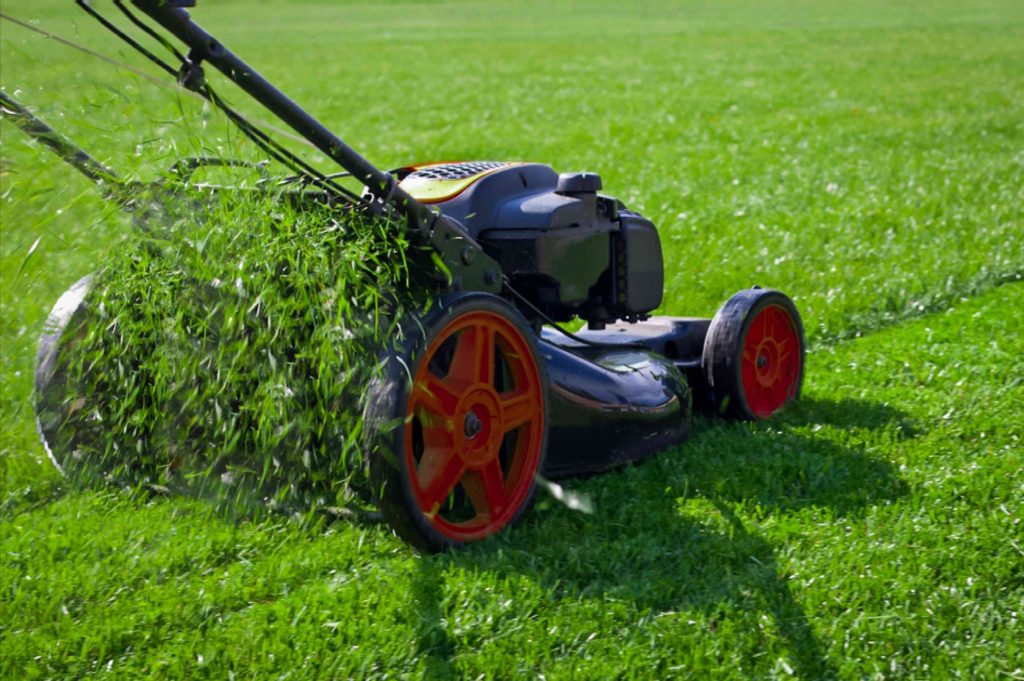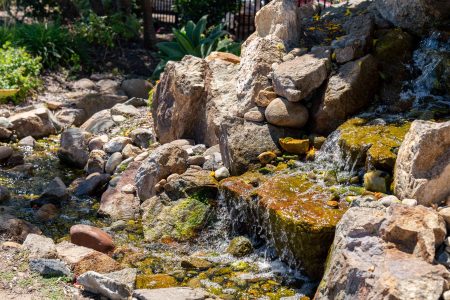When spring is in the air, the first crocuses and daffodils appear to mark the coming of the season. These early signs also tell to you that it’s time to get your lawn ready.
The exact timing of lawn care tasks depends upon the climate in your region. If you get snow in your area, start when you are confident the snow has stopped. Or, start your yard work when the local forsythia plants begin blooming or lilac bushes begin to flower.
For homeowners in most regions, there are certain tasks you should complete in the spring to foster a healthy lawn the rest of the year. Make a checklist of these steps, and you’ll be off to a green start.
Spring Lawn Care Steps
-
Rake Gently
Raking is the first thing you need to do to prepare your lawn for new growth. You may still have a few fallen leaves on the ground, however early spring raking is done primarily to remove thatch that is deeper than 1/2 inch.
What Is Thatch?
Thatch is the layer of dead turfgrass from the previous year. If this layer becomes too thick (1/2 inch or more), it can be bad for the health of your grass, but a thin layer naturally helps protect the soil by preserving moisture and nutrients.
Think of this as a spring-cleaning for your lawn. Turfgrasses are somewhat tender and vulnerable in the early spring, however, so it’s best to wait until the lawn begins to green up, which signifies the grass blades are firmly rooted and the plants are actively growing.
Using a flexible leaf rake, rake thoroughly but gently to help break up deep thatch. If you notice lots of grass blades stuck together, a lawn disease called snow mold may be to blame. New grass may have difficulty penetrating these matted patches, and raking can solve the problem.
-
Aerate if Necessary
If your lawn gets heavy traffic, such as lots of running and playing in the same spot, this can cause soil compaction.
A lawn aerator creates openings in lawn turf that allows water and air to penetrate the soil and reach the grassroots. You can rent a lawn aerator at a big box hardware store, or, if you have a small lawn, use a hand aerator to do it.
Spring is not the ideal time to aerate the lawn, but circumstances may require it. If soil is compacted to the point that existing grass can’t grow, it may be necessary to aerate in the spring.
Generally, though, spring aerating is discouraged because the aeration holes provide a perfect spot for weed seeds to germinate. Lawn weeds (especially crabgrass) are the first seeds to germinate in the spring, and aerating the lawn stirs them up and gives them an ideal home.
If you must aerate in the spring, consider doing it around Memorial Day, after weeds have started growing but before they go to seed.
-
Assess the Soil
Moss coating the ground can also be a sign of acidic soil. The acidity or alkalinity of soil is measured by the pH scale, with 7 representing perfectly neutral soil. Acidic soils have pH levels below 7, while alkaline soils measure higher than 7.
Grass likes a neutral pH, and, if your soil is well outside this range it can be subject to moss growth. A variety of soil amendments can be used to nudge the pH back to an optimal level for growing grass. Adding ground limestone, for example, is a common method for lifting the pH of acidic soils. However, this is not a quick fix, as the liming takes hold gradually.
Before you add soil amendments, send a soil sample to your local cooperative extension office to determine your soil’s acidity. The cooperative extension office is a free educational resource offering scientific-based assistance in agriculture, horticulture, and other areas of expertise. All you have to do is call, check on their website, or visit your local extension office, and they can advise you on how much lime per square foot you’ll need. You will need a fertilizer drop spreader to apply the lime.
Soil that is too alkaline can also cause lawn problems. Your extension office may recommend a top-dressing of compost or elemental sulfur to lower the pH of extremely alkaline soils.
-
Overseed
A lawn riddled with bare patches due to dog spots, heavy traffic, or neglect may need an application of grass seed to fill in those patches. Overseeding is the process of sowing seed over existing grass. Apply a slow-release nitrogen fertilizer (starter fertilizer) when you overseed. Keep the new seed moist until it has sprouted and is actively growing. Five weeks after the grass germinates and sprouts, you can begin a normal fertilization routine using quick-release nitrogen fertilizer.
It is possible to apply seed only to the visible bare patches, but it is also quite common to overseed the entire lawn to ensure that the lawn remains thick and healthy. This can also be a way to introduce new varieties of grass seed into your lawn. For example, if you’ve recently lost some shade trees, overseeding with a sunny-grass mix can help your previously shady lawn continue to thrive.
Fall is the preferred time to do your overseeding, but if your grass is in dire need of help, you can do it in spring. Be prepared to contend with some crabgrass cropping up and feeding off the fertilizer.
-
Fertilize
Lawns can be fertilized organically by topdressing with compost or using a mulching mower to chop lawn clippings into a nourishing source of nitrogen. But, for those who prefer the fast-acting effects of a chemical fertilizer, the ScottsMiracle-Gro company provides a widely accepted schedule for fertilizing lawns that includes a spring feeding.
However, many experts recommend a lighter feeding in spring and a heavier one in late fall for cool-season grasses. Too much fertilizer in spring can lead to disease and weed problems, and if you fertilized in late fall your lawn still has fertilizer to feed on in spring.
-
Apply Pre-Emergent Herbicides
For those who prefer weed-free lawns, spring lawn care is as much about weed prevention as it is about fostering healthy lawn growth. You do not get rid of all lawn weeds in the same manner. Depending upon whether a weed is annual or perennial, you will use either a pre-emergent herbicide or a post-emergent herbicide.
To fight crabgrass, you may need to use both, since this annual weed is very tough to eradicate. Crabgrass begins its assault on lawns in spring when temperatures are 65 to 70 degrees for several days. Pre-emergent herbicides address weeds before their seedlings can even emerge. They work by forming a chemical barrier in the top layer of soil that coats seeds and prevents them from growing roots and shoots.
If you are using pre-emergent herbicides, don’t plan on doing any core aeration until the fall. You will puncture the shield and decrease the weed killer’s effectiveness.
And be aware that most pre-emergent herbicides also work against grass seeds. Overseeding is not very effective if you’re also applying a traditional pre-emergent herbicide. In years where you are laying down pre-emergent weed killer, wait until early fall to do your overseeding with turfgrass seed.
-
Apply Post-Emergent Herbicides (Or Pull Spring Weeds)
Dandelions are cheerful yellow flowers that are also stubborn perennial growers, first making their appearance in the spring. To get rid of this weed, snap off their flower stems before they produce seeds. Or, if you are more ambitious, dig them out by the roots using a tool that will extract the entire root and keep it from resprouting. A variety of weed-popper tools are available that do a good job.
If you choose to spray a post-emergent herbicide for dandelions, get one formulated for broadleaf weeds. For organic green thumbs who do not use pesticides or herbicides on the lawn, you can harvest the dandelion greens by hand.
Other spring weeds to deal with include chickweed, white clover, wild violets, and others, though these usually make their appearance after the dandelions, in late spring and into summer.
-
Service the Lawnmower
Spring also means it’s time to get out the lawn mower and give it a once over. Start it up; stubborn start-ups are a sign that it might be due for a tune-up. Give your mower a tune-up once a year. In three easy steps, you can get your mower back in tip-top shape. If your lawnmower needs more than a tune-up, then consider getting a new one.
Among the key tune-up tasks is sharpening the mower blade. A regular sharpening will ensure the blade severs, rather than tears, the grass plants, leading to a nice green lawn rather than one with ragged brown tips.
Read the full article here









